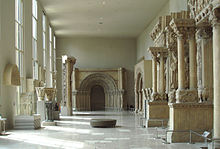- Musée national des Monuments Français
-
The Musée national des Monuments Français is a museum of French monuments located in the Palais de Chaillot, 1, place du Trocadéro et du 11 Novembre, Paris, France. It now forms part of the Cité de l'Architecture et du Patrimoine, and is open daily except Tuesday. An admission fee is charged.
Contents
Collections
 Molding of the portal of the Church of Saint-Pierre d'Aulnay, Aulnay-de-Saintonge, mid-12th century.
Molding of the portal of the Church of Saint-Pierre d'Aulnay, Aulnay-de-Saintonge, mid-12th century.
It contains about 6,000 casts of sculptures of all periods including ancient Greece, Italy, Germany, and Switzerland, but with a strong emphasis on French sculptures of the Romanesque and Gothic periods. It also contains scale models of buildings, copies of architectural elements, sculpture, frescoes, and stained glass from French churches and châteaux, as well as a collection of about 200,000 photographs. Most copies were made in the late 19th and early 20th centuries.
Of particular interest is the Galerie Davioud, which displays casts of sculptures from the Strasbourg Cathedral (13th century), Bourges Cathedral (late 13th century), and the Notre-Dame de Reims. The museum also contains copies of elements from Angoulême Cathedral, Aulnay, Autun, Cluny, Conques, Jouarre, Moissac, Sainte-Marie-des-Dames at Saintes, Saint-Gilles-du-Gard, Saint-Trophime d'Arles, Saint-Génis-des-Fontaines, Saint-Sernin at Toulouse, and Notre-Dame du Port at Clermont-Ferrand.
History
Alexandre Lenoir
In 1795, Alexandre Lenoir opened the Musée des monuments français to the public and served as its administrator for 30 years, but he had to restore most of its collections to their former private and public owners on the Bourbon Restoration in 1816. What remained would be partly moved to the Louvre in 1824 (in the galerie d'Angoulême under the generic term of musée de la sculpture française) and partly in the musée de Versailles in 1836.
Viollet-le-Duc
The architect Eugène Viollet-le-Duc suggested gathering reproductions of French sculpture and architecture at a single site in the palais du Trocadéro in 1879, in buildings left vacant after the Exposition universelle in 1878. His proposal was accepted on 4 November. Alexandre du Sommerard would be designated on 20 December to form the musée de la Sculpture comparée. The institution opened its four rooms to the public on 28 May 1882, three more in 1886 and finally its library and foundational documents in 1889.
The palais du Trocadéro, almost completely destroyed under the direction of architect Jacques Carlu for the Exposition universelle of 1937, became the palais de Chaillot. Wholly redesigned, the museum became the musée des Monuments français. Very avant-garde in terms of its museographic conception and intellectual experimentation, notably through the efforts of the archaeologist Paul Deschamps, he had to close its doors due to an insufficient budget. In July 1995, a fire partially destroyed the building. Its planned reopening in 1998 was pushed back to 15 September 2007 in connection to the creation of the Cité de l'Architecture et du Patrimoine.
Today
It occupies the aile Paris of the Palais de Chaillot and is made up of 3 galleries. The galerie Davioud and galerie Carlu form a gallery of plaster casts. The upper gallery serves as an exhibition space for modern and contemporary architectural models. Wall paintings and stained glass windows are located at the end of the modern and contemporary architecture gallery; they are shown on two levels. There is also a library as well as rooms for temporary exhibitions.
See also
References
Categories:- Museums in Paris
Wikimedia Foundation. 2010.


